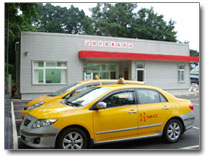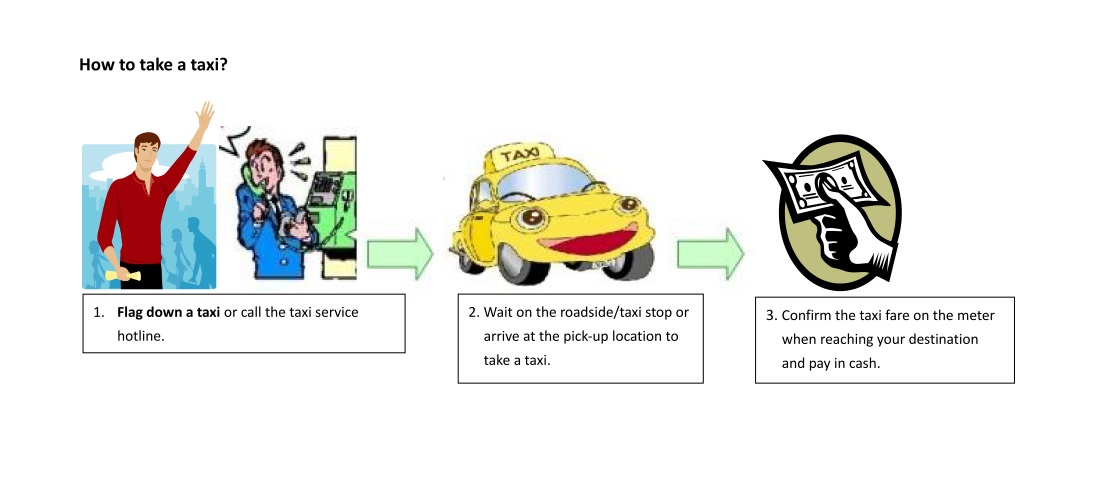Taxi Profile
Taxi Profile In the 1960s, cars were widely used in many developed countries and cycle rickshaws were gradually replaced by taxis. But in the primary stage, the government didn't control the number of taxis. Obtaining a taxi driving license was easy and the number of taxis increased rapidly. From three days before Chinese New Year's Eve to the end of holidays for the Lunar New Year period 1.No extra fare-charged at nighttime: Based on the fixed taxi fare table, 'extra fare-charged at nighttime', and NT$30 is charged each journey. Waiting time fee Waiting time fee Apart from 'extra fare-charged at nighttime', NT$20 is charged for each journey. Operation Information Based on taxi operation statistics, Taipei City has the greatest number of taxis, 30,000. The number has dropped from around 39,000 taxis after the establishment of the taxi cooperative in 1996. According to the investigation of taxi operation in Taipei City in 2010, taxi drivers in Taipei City work a median 27-28 days per month; 10.49 hours per day; taxi in vacancy was around 6.63 hours; 15.81 rounds; 169 km; The pay is NT$2657 per day. Taipei City Public Transportation Office planned to improve taxi service quality while slashing the time that the taxi is left vacant. In order to improve the taxi service quality, Taipei City Public Transportation Office has set up one hundred and seventy taxi stands until May 2012,including MRT stations, department stores and hospitals etc. How to take a taxi When did taxi services start in Taipei? It should be dated back to the Japanese Colonial Period. However at that time, taxis were for the wealthy exclusively, such as the Lin family from Banciao. Most people used cycle rickshaws instead. In the late 1950s, taxis were introduced in Taiwan.
When did taxi services start in Taipei? It should be dated back to the Japanese Colonial Period. However at that time, taxis were for the wealthy exclusively, such as the Lin family from Banciao. Most people used cycle rickshaws instead. In the late 1950s, taxis were introduced in Taiwan.
As a result, the Ministry of Transportation and Communications started to exercise more control. But the ease of acquiring taxi driver's licenses and the approval of a taxi cooperative further increased the number of taxis. That number reached a peak of 39,408. Eventually, the establishment of a Taipei Bus network and the Taipei MRT led to a yearly decrease in the number of taxis.
The 1990s saw the emergence of taxi fleets owned by different companies such as Evergreen, Lian-jiou, Cheng-kung, Jiu-yi, Taiwan Taxi, Da-ai, and so on. Each fleet sought to provide the best service to passengers as part of a campaign to improve Taipei City’s image, and to increase competition.
In the past, it was confusing for passengers to distinguish private cars from taxis. For example, it was difficult to tell them apart at midnight; it confused foreigners because taxis did not have a common designated color. Furthermore, some drivers had illegally installed taxi overhead lamps, thus aggravating taxi service management for the government . So on 6th June 1990, the Taipei City Taxi Business Association decided on "yellow" as the best color for taxis, after conducting a survey with questionnaires.
On 1st Jan 1991, the Car Transportation Management Regulation no.91, mandated "Yellow hue no. 18" as the standard color for taxis.
The color yellow is eye-catching, easy to recognize, and car owners will unlikely choose it as the color for their own cars. Many countries have their own particular colors for their taxis. But in Taiwan, when you say "hsiao-huang" (little yellow thing), "taxi" comes to mind.Daytime (06:00~23:00) Nighttime (23:00~06:00) Extra fare charged during Chinese New Year Service Charge Begin the journey NT$85 (1.25 km) Begin the journey NT$85 (1.25 km)
2.Extra fare-charged at nighttime: Apart from 'extra fare-charged at nighttime', NT$50 is charged for each journey.Along the journey NT$5 (per 200m) Proceed the journey NT$5 (per 200m) NT$5 (per 60 sec) NT$5 (per 60 sec) Additional charge of NT$ 20- per trip Notes 'Extra fare-charged' as required 

![Taiwan.gov.tw [ open a new window]](/images/egov.png)
